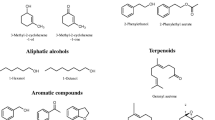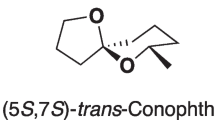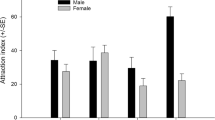Abstract
In laboratory olfactometer bioassays, females of two hymenopteran parasitoid species, Roptrocerus xylophagorum(Ratzeburg) (Hymenoptera: Pteromalidae) and Spathius pallidus(Ashmead) (Hymenoptera: Braconidae), were attracted to odors from bark or bolts of loblolly pine, Pinus taeda L., colonized by bluestain fungi (genus Ophiostoma) associated with the parasitoids' bark beetle hosts. Mock-inoculated bolts and bark were less attractive or unattractive in these bioassays. Bark infested with host larvae that lacked their fungal and other normal microbial associates was attractive to R. xylophagorum females, but was less so than bark infested with larvae possessing their normal complement of associated microbes. In contrast, in oviposition bioassays, R. xylophagorum females spent approximately equal time searching, made similar numbers of oviposition attempts, parasitized similar percentages of hosts, and laid similar numbers of eggs in bark fragments infested with either associate-free or associate-bearing host larvae. Furthermore, in field bioassays using bluestain-inoculated or mock-inoculated loblolly pine bolts as sources of attractants, the numbers of parasitoids attracted by the two treatments did not differ significantly and the two treatments were less attractive than bolts naturally infested with bark beetle larvae. Whereas our laboratory olfactometer data suggest that bark beetle fungal associates may enhance attraction of some parasitoids, our bioassays with associate-free hosts indicate that associate-produced are not required for short-range host location and parasitization. In addition, our field trials indicated that long-range attraction of parasitoids to the host-fungi-tree complex is not caused simply by an interaction between bluestain fungi and tree tissues.
Similar content being viewed by others
REFERENCES
Barras, S. J. 1970. Antagonism between Dendroctonus frontalis and the fungus Ceratocystis minor. Ann. Entomol. Soc. Am. 63:1187–1190.
Barras, S. J. 1972. Improved White's solution for surface sterilization of pupae of Dendroctonus frontalis. J. Econ. Entomol. 65:1504.
Birgersson, G., Dalusky, M. J., Espelie, K. E., and Berisford, C. W. 1992. Isolation and identification of kairomones utilized by southern pine beetle parasitoids, p. 30, in D. C. Allen and L. P. Abrahamson (eds.). Proceedings: North American Forest Insect Work Conference, 25–28 March 1991, Denver, Colorado. USDA Forest Service Gen. Tech. Rpt. PNW-GTR-294.
Bramble, W. C. and Holst, E. C. 1940. Fungi associated with Dendroctonus frontalis in killing shortleaf pines and their effect on conduction. Phytopathology 30:881–899.
Brand, J. M. and Barras, S. J. 1977. The major volatile constituents of a Basidiomycete associated with the southern pine beetle. Lloydia 40:398–400.
Brand, J. M., Schultz, J., Barras, S. J., Edson, L. J., Payne, T. L., and Hedden, R. L. 1977. Enhancement of Dendroctonus frontalis (Coleoptera: Scolytidae) aggregation pheromone by yeast metabolites in laboratory bioassays. J. Chem. Ecol. 3:657–666.
Bridges, J. R., Marler, J. E., and McSparrin, B. H. 1984. A quantitative study of the yeasts and bacteria associated with laboratory-reared Dendroctonus frontalis Zimm. (Coleopt.: Scolytidae). J. Appl. Entomol. 97:261–267.
Bushing, R. W. 1965. A synoptic list of the parasites of Scolytidae (Coleoptera) in North America north of Mexico. Can. Entomol. 97:449–492.
Cook, S. P. and Hain, F. P. 1985. Qualitative examination of the hypersensitive response of loblolly pine, Pinus taeda L., inoculated with two fungal associates of the southern pine beetle, Dendroctonus frontalis Zimmermann (Coleoptera: Scolytidae). Environ. Entomol. 14:396–400.
Dahlsten, D. L. and Berisford, C. W. 1995. Diversity of bark beetle natural enemies, pp. 184–201, in F. P. Hain, S. M. Salom, W. F. Ravlin, T. L. Payne, and K. F. Raffa (eds.). Behavior, Population Dynamics, and Control of Forest Insects: Proceedings of the International Union of Forestry Research Organizations, Joint Conference, 6–11 February 1994, Maui, Hawaii.
Dehoog, G. S. and Morgan-Jones, G. 1978. Notes on Hyphomycetes. XXIII. Paraphaeosaria alabamensis gen. et sp. nov. Mycotaxon 7:133–138.
Dicke, M. 1988. Microbial allelochemicals affecting the behavior of insects, mites, nematodes, and protozoa in different trophic levels, pp. 125–163, in P. Barbosa and D. K. Letourneau (eds.). Novel Aspects of Insect-Plant Interactions. Wiley, New York.
Fox, J. W., Wood, D. L., Akers, R. P., and Parmeter, J. R., Jr. 1993. Survival and development of Ips paraconfusus Lanier (Coleoptera: Scolytidae) reared axenically and with tree-pathogenic fungi vectored by cohabitating Dendroctonus species. Can. Entomol. 125:1157–1167.
Hanssen, H. P. 1993. Volatile metabolites produced by species of Ophiostoma and Ceratocystis, pp. 117–126, in M. J. Wingfield, K. A. Seifert, and J. F. Webber (eds.). Ceratocystis and Ophiostoma. APS Press, St. Paul, MN.
Howe, V. K., Oberle, A. D., Keeth, T. G., and Gordon, W. J. 1971. The role of microorganisms in the attractiveness of lightning-struck pines to southern pine beetles. Western Illinois University Series in the Biological Sciences No. 9.
Kudon, L. H. and Berisford, C. W. 1981. An olfactometer for bark beetle parasites. J. Chem. Ecol. 7:359–366.
Leufven, A., Bergstrom, G., and Falsen, E. 1988. Oxygenated monoterpenes produced by yeasts, isolated from, Ips typographus (Coleoptera: Scolytidae) and grown in phloem medium. J. Chem. Ecol. 14:353–362.
Madden, J. L. 1968. Behavioral responses of parasites to the symbiotic fungus associated with Sirex noctilio. Nature 218:189.
Mills, N. J. 1983. The natural enemies of scolytids infesting conifer bark in Europe in relation to biological control of Dendroctonus spp. in Canada. Biocontrol News Inf. 4:305–328.
Mills, N. J., Kruger, K., and Schlup, J. 1991. Short-range host location mechanisms of bark beetle parasitoids. J. Appl. Entomol. 111:33–43.
Paine, T. D., Blanche, C. A., Nebeker, T. E., and Stephen, F. M. 1987. Composition of loblolly pine resin defenses: Comparison of monoterpenes from induced lesion and sapwood resin. Can. J. Forest Res. 17:1202–1206.
Paine, T. D., Raffa, K. F., and Harrington, T. C. 1997. Interactions among scolytid bark beetles, their associated fungi, and live, host conifers. Annu. Rev. Entomol. 42:179–206.
Paine, T. D. and Stephen, F. M. 1987. Fungi associated with the southern pine beetle: Avoidance of induced defense response in loblolly pine. Oecologia 74:377–379.
Payne, T. L. 1989. Olfactory basis for insect enemies of allied species, pp. 55–69, in D. L. Kulhavy and M. C. Miller (eds.). Potential for Biological Control of Dendroctonus and Ips Bark Beetles. University of Texas Press, Austin, TX.
Pettersson, E. M. 2001a. Volatile attractants for three Pteromalid parasitoids attacking concealed spruce bark beetles. Chemoecology 11:89–95.
Pettersson, E. M. 2001b. Volatiles from potential hosts of Rhopalicus tutela, a bark beetle parasitoid. J. Chem. Ecol. 27:2219–2231.
Pettersson, E. M., Birgersson, G., and Witzgall, P. 2001a. Synthetic attractants for the bark beetle parasitoid Coeloides bostrichorum Giraud (Hymenoptera: Braconidae). Naturwissenschaften 88:88–91.
Pettersson, E. M., Hallberg, E., and Birgersson, G. 2001b. Evidence for the importance of odour-perception in the parasitoid Rhopalicus tutela (Walker) (Hym., Pteromalidae). J. Appl. Entomol. 125:293–301.
Pettersson, E. M., Sullivan, B. T., Anderson, P., Berisford, C. W., and Birgersson, G. 2000. Odor perception in the bark beetle parasitoid Roptrocerus xylophagorum exposed to host associated volatiles. J. Chem. Ecol. 26:2507–2525.
Raffa, K. F. and Berryman, A. A. 1982. Accumulation of monoterpenes and associated volatiles following inoculation of grand fir with a fungus transmitted by the fir engraver, Scolytus ventralis (Coleoptera: Scolytidae). Can. Entomol. 114:797–810.
Raffa, K. F. and Smalley, E. B. 1995. Interaction of pre-attack and induced monoterpene concentrations in host conifer defense against bark beetle-fungal complexes. Oecologia 102:285–295.
Rumbold, C. T. 1931. Two blue-staining fungi associated with bark-beetle infestation of pines. J. Agric. Res. 43:847–873.
Russell, C. E. and Berryman, A. A. 1976. Host resistance to the fir engraver beetle. 1. Monoterpene composition of Abies grandis pitch blisters and fungus-infected wounds. Can. J. Bot. 54:14–18.
Salom, S. M., Ascoli-Christensen, A., Birgersson, G., Payne, T. L., and Berisford, C. W. 1992. Electroantennogram responses of the southern pine beetle parasitoid Coeloides pissodis (Ashmead) (Hym., Braconidae) to potential semiochemicals. J. Appl. Entomol. 114:472–479.
Salom, S. M., Birgersson, G., Payne, T. L., and Berisford, C. W. 1991. Electroantennogram responses of the southern pine beetle parasitoid Dinotiscus dendroctoni (Ashmead) (Hymenoptera: Pteromalidae) to potential semiochemicals. J. Chem. Ecol. 17:2527–2538.
Samson, P. R. 1984. The biology of Roptrocerus xylophagorum (Hym.:Torymidae), with a note on its taxonomic status. Entomophaga 29:287–298.
Six, D. L. and Dahlsten, D. L. 1999. Interactions of bark beetle natural enemies and beetle-associated fungi, pp. 41–43, in E. M. Goheen (ed.). Proceedings of the Fifth Joint Meeting of the Western International Forest Disease Work Conference and Western Forest Insect Work Conference, 13–17 September 1999, Breckenridge, CO.
Six, D. L. and Paine, T. D. 1998. Effects of mycangial fungi and host tree species on progeny survival and emergence of Dendroctonus ponderosae (Coleoptera: Scolytidae). Environ. Entomol. 27:1393–1401.
Sokal, R. R. and Rohlf, F. J. 1995. Biometry. W. H. Freeman, New York.
Solheim, H. 1992. The early stages of fungal invasion in Norway spruce infested by the bark beetle Ips typographus. Can. J. Bot. 70:1–5.
Spradberry, J. P. 1970. The biology of Ibalia drewseni Borries (Hymenoptera:Ibaliidae), a parasite of siricid woodwasps. Proc. R. Entomol. Soc. Lond. 45:104–113.
SPSS. 1997. SigmaStat® 2.0 for Windows® User's Manual. SPSS Inc., Chicago, IL.
Sullivan, B. T. 1997. The chemical ecology of host habitat location by larval parasitoids of the southern pine beetle, Dendroctonus frontalis Zimmermann: Olfactory cues and their possible sources. PhD Dissertation, University of Georgia, Athens, GA.
Sullivan, B. T., Berisford, C. W., and Dalusky, M. J. 1997. Field response of southern pine beetle parasitoids to some natural attractants. J. Chem. Ecol. 23:837–856.
Sullivan, B. T., Pettersson, E. M., Seltmann, K. C., and Berisford, C. W. 2000. Attraction of the bark beetle parasitoid Roptrocerus xylophagorum (Hymenoptera: Pteromalidae) to host-associated olfactory cues. Environ. Entomol. 29:1138–1151.
Sullivan, B. T., Seltmann, K. C., and Berisford, C. W. 1999. A simple continuous-rearing technique for the bark beetle parasitoid, Roptrocerus xylophagorum (Ratzeburg). J. Entomol. Sci. 34:260–264.
Thibout, E., Guillot, J. F., and Auger, J. 1993. Microorganisms are involved in the production of volatile kairomones affecting the host seeking behaviour of Diadromus pulchellus, a parasitoid of Acrolepiopsis assectella. Phys. Entomol. 18:176–182.
Upadhyay, H. P. 1981. A Monograph of Ceratocystis and Ceratocystiopsis. University of Georgia Press, Athens, GA.
Vet, L. E. M., WÄckers, F. L., and Dicke, M. 1991. How to hunt for hiding hosts: The reliability-detectability problem in foraging parasitoids. Neth. J. Zool. 41:202–213.
Whitney, H. S. 1971. Association of Dendroctonus ponderosae (Coleoptera: Scolytidae) with blue stain fungi and yeasts during brood development in lodgeple pine. Can. Entomol. 103:1495–1503.
Yearian, W. C., Gouger, R. J., and Wilkinson, R. C. 1972. Effects of the bluestain fungus, Ceratocystiopsis ips, on development of Ips bark beetles in pine bolts. Ann. Entomol. Soc. Am. 65:481–487.
Author information
Authors and Affiliations
Rights and permissions
About this article
Cite this article
Sullivan, B.T., Berisford, C.W. Semiochemicals from Fungal Associates of Bark Beetles May Mediate Host Location Behavior of Parasitoids. J Chem Ecol 30, 703–717 (2004). https://doi.org/10.1023/B:JOEC.0000028426.37482.17
Issue Date:
DOI: https://doi.org/10.1023/B:JOEC.0000028426.37482.17




